A beautiful manicure can be done not only in the salon, but also at home, and with your own hands. To do this, just use a regular nail polish. If all the actions are performed correctly and creatively approached, the manicure can turn out to be unusual and will remain in its original form for a long time.
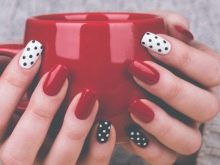
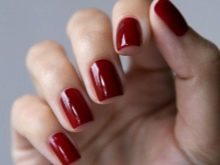

Manicure Features
When the master in the salon paints and nails the client with precise, precise movements, this activity seems completely uncomplicated. But it’s worth trying at home to make a manicure an ordinary varnish for yourself, and this can turn into a real hassle. The left (and for someone the right) hand does not obey and makes strange curved strokes, the fingers are blotched, and on the nail plate itself, the varnish, in general, comes in bubbles.
With regular exercises to create a manicure at home, such problems become less.
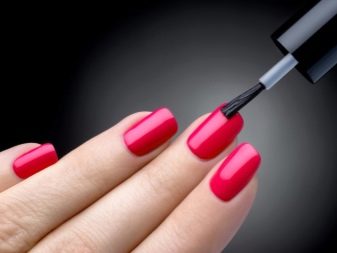
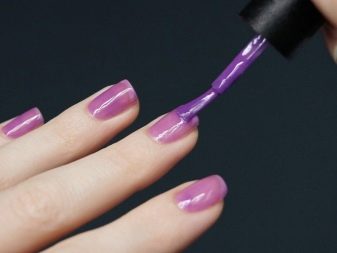
Advantages and disadvantages
The use of ordinary varnish, in comparison with analogues of a later origin, has its advantages and disadvantages. Among its advantages are the following:
- such varnish is relatively inexpensive;
- to dry ordinary nail polish, do not need special equipment;
- a new manicure can be performed at least every other day, creating a new design as you wish;
- using such a tool, the nail plate almost does not suffer, since the varnish does not adhere to it, which means that the nail does not thin.
All this has its opposite side:
- in comparison with more "advanced" counterparts, such a varnish serves in a matter of days;
- many ordinary varnishes have an unpleasant odor due to the components that make up their composition.
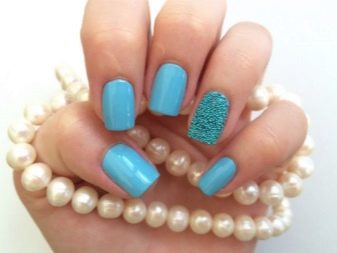
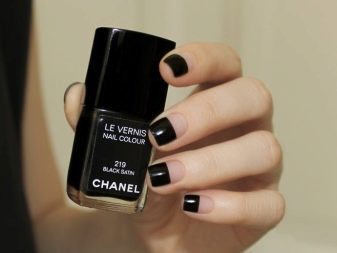
Preparation of tools and materials
To do manicure yourself, you can not do without a set of certain tools and materials.
Prepare:
- regular varnish (or several, of different colors);
- means for a transparent base coat - primer;
- means for fixing the color coating;
- nail polish remover;
- hand cream;
- cotton pads and cotton buds;
- tassels;
- an antiseptic, for example, an alcohol solution for disinfection.
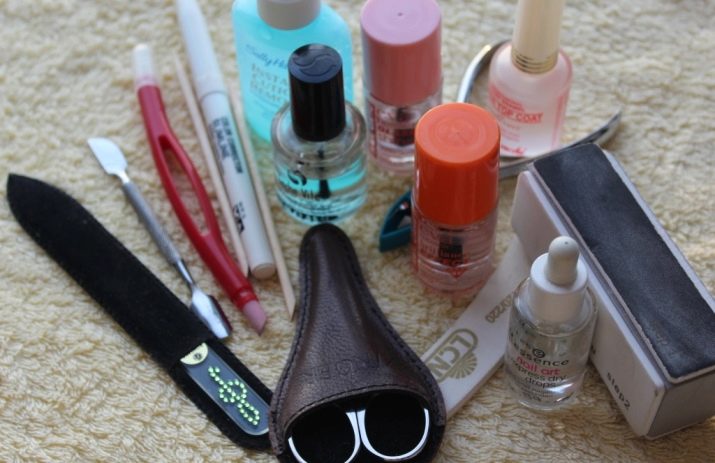
Varnishing Technique
Manicure needs to be done after a long time after leaving the bath, shower or after other contact with the liquid. Even if you wipe your hands well, moisture will remain in the pores for several hours. It can adversely affect the final result.
To begin with, you should properly prepare the nails themselves for decoration. It is necessary to erase from them the traces of the previous staining and give them the shape that you like more. They can be square, oval, pointed, have rounded corners and so on.
If the skin around the nails requires treatment, you will have to deal with it: make a bath and soften the cuticle, put it in order.
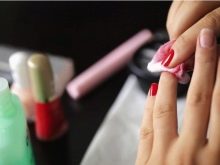

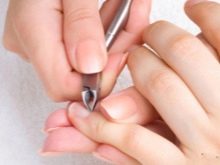
In order for the varnish to firmly adhere to the surface of the nail, it is necessary to grind and polish the plate itself. To do this, you need a nail file and buff. Then wipe off the dust from the nails after processing and degrease their surface.
Starting to stain, you need to make sure that your elbows have support. You can not paint your nails while keeping your hands on the weight. This can ruin the whole thing, and you have to start work again.
First of all, apply the base. The base transparent (or white) layer will allow you to better connect a regular varnish to the surface intended for it and will not allow it to soak inward, making the nails yellowish in appearance after removing the coloring agent.

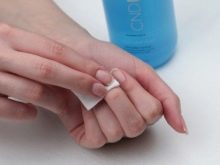
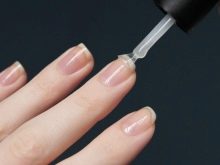
Apply a color layer to them starting with the little finger on the hand that is working. That is, right-handed - from the right hand, and vice versa. The movement from the little finger to the thumb will not spoil the already applied coating when staining the following nails on the hand.
It is better to pre-warm the bottle with varnish in the palms., you can shake it, but it is not recommended to do it too much: then air bubbles can form inside, which subsequently distort the varnish on the painted surface.
To gently paint your nails, you need to remove the brush from the bottle by running one side of the neck: then there will not be too much coloring agent and it will not flow where it is not needed.
You need to paint correctly: by making a smear, first from the middle to the edge, and then back to the side of the hole. After that, walk along the sides and finally draw a brush on the end of the nail to seal it.
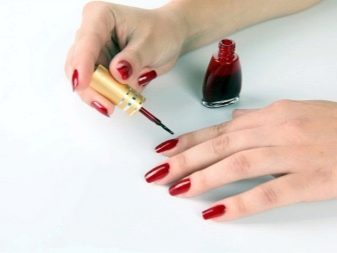
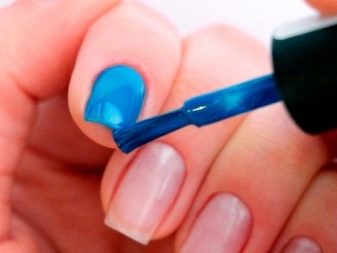
If there is no experience and there is a risk of smearing the skin or you want the nail to look more elegant and longer, you can not bring the brush to the edge on the sides of the plate at a distance of about a millimeter.
After waiting a little, apply a second coat of varnish, and after drying, fix it with a transparent finish, making the same movements as in the distribution of conventional dye. The topcoat will give the manicure a nice glossy sheen.
To keep the manicure longer, for several hours after the completion of the coating procedure, you must not have contact with water. Therefore, ordinary women's household chores have to be postponed: do not do the washing up, do not wash the floors, and the like.
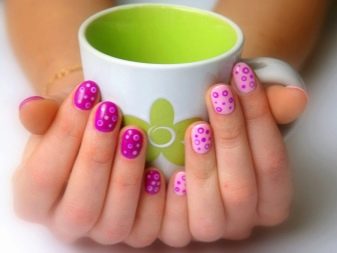

Precautions
Even if manicure is considered a harmless process, safety precautions will not hurt. You need to choose a convenient place for such an activity. All items necessary for work, including a bottle with a varnish, should be located on a surface so that they could not be touched, turned over or shaken off the table.
It is advisable to keep the window open, especially in cases where the pungent smell of acetone is too irritating to the respiratory system.
During the guidance of beauty on the nails, it is better to make sure that children do not spin around. They do not need to have contact with manicure accessories.
If the varnish itself gets into the eyes of a curious child, which sometimes also happens, you should rinse it quickly with water or tea leaves, although it is possible that after such adventures you still have to see a doctor.


FAQ
During the independent creation of manicure, various difficulties often arise.
What to do if dry?
It happens that the varnish is used irregularly. It thickens, hardens, and even the bottle itself does not open anymore, because its contents have dried on the neck.
To open the bottle, you can put it under hot water for a short time so that the lid gets under it. If this does not help, hold the bottle under the heated liquid for half a minute. You can try to immediately unscrew the lid, but so that water does not get inside the bottle.
You can just put the bottle upside down in a glass of hot water for about five minutes. After this, the bottle should be wiped and again try to move the upper part of the bottle by thread. To make this easier, you can tightly wrap an elastic band around it. Then grasp the lid with your fingers will be more convenient.
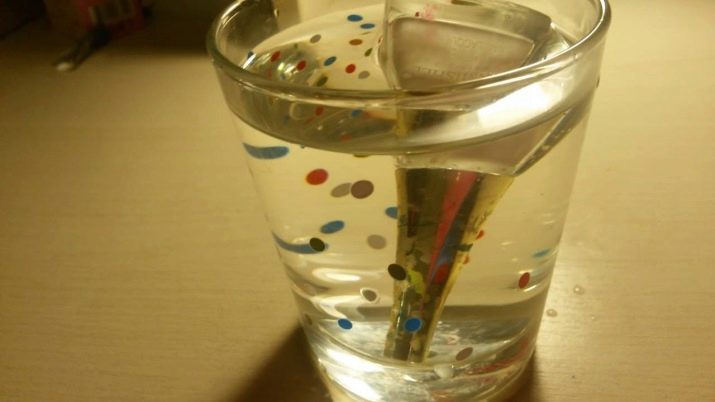
Also, the base of the lid can be wetted with a solvent using a cotton swab. Nail polish remover or acetone will “eat” the dried varnish, and it will be easier to open the bottle.
It is also convenient to return the fluidity to the varnish itself using hot water, although in some cases it can be made liquid only thanks to the solvent. A large amount of this tool does not need to be added immediately. It is better to act in stages, achieving the desired consistency of varnish.
There are also special products that can be used to dilute the coloring agent. Such thinners themselves look like transparent varnishes. You can use them based on the instructions for use.
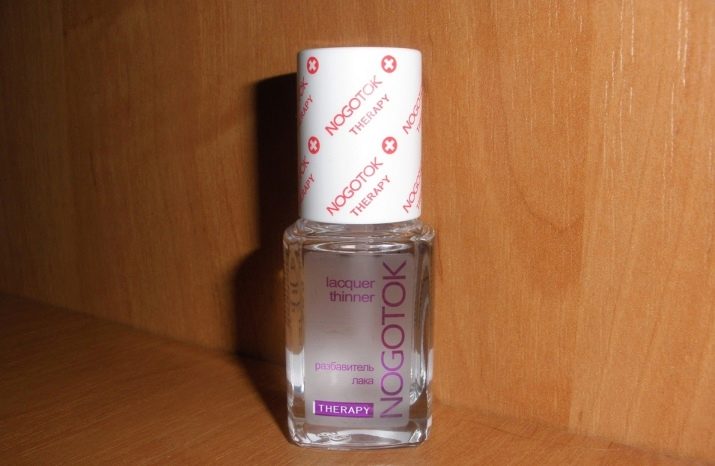
In order not to have to "revive" the dried varnish, it is better not to create situations for its drying. Do not store such bottles in the refrigerator, as well as in the nightstand by the heating radiator or under the window. Both too high and too low temperatures equally affect the coloring compounds. You need to find a cool dark place for the bottles.
After using the varnish, the neck of the bottle should be wiped with a nail polish remover. This will not allow the lid to stick.
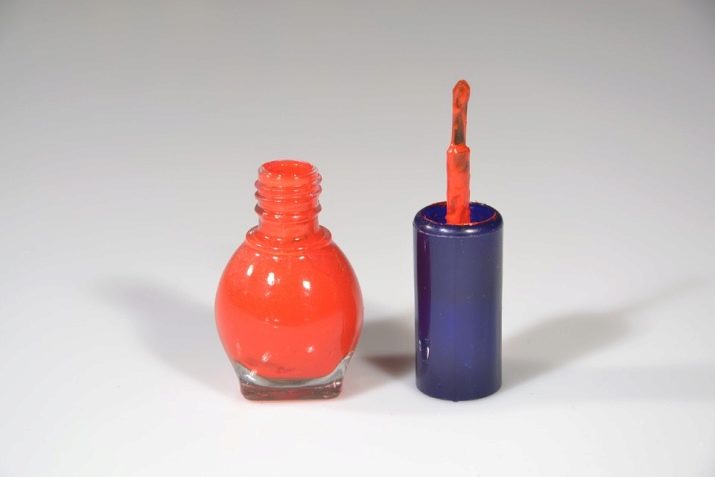
What to do if it does not dry?
The problem with ordinary varnish is its slow drying. It takes ten to twenty minutes to wait for a reliable setting of each layer.
In order not to have to wait long, you can use special sprays or liquids that are distributed over the nails with a brush. This allows the varnish to dry in a minute.
You can apply a drop of vegetable oil to your nails within a couple of minutes after applying the varnish. This speeds up the drying process by half.
You can even use an ordinary hairdryer. It is turned on without heating. To prevent varnish, do not bring the device too close to your fingers.

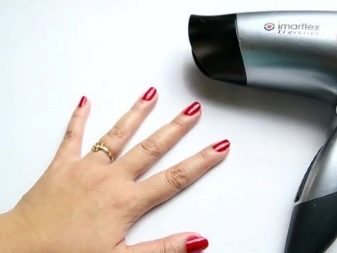
How to erase?
Sometimes when applying varnish to the nails, it bubbles. This may be due to the ingress of water into the coloring composition, or, perhaps, the decorative product simply expired. Then the varnish will have to be erased and applied again. You can use a cotton pad soaked in a special liquid to remove it.
Some make nail corrector from improvised means. In a small bottle with nail polish remover, a piece of foam rubber rolled into a spiral is screwed. It is enough to put a finger in the foam soaked in liquid. After that, the varnish will be removed with a slight movement.
It often happens that the varnish does not rub off the skin around the nails.This can happen due to the inexperience of a girl who paints her nails herself or because of the use of various devices to create patterns and decorative prints on her nails.
To remove blots from the skin, nail polish remover helps. She can soak a cotton swab and rub her fingers. You can use a special corrector, the core of which is impregnated with a means for removing varnish.
You can also use a flat brush, which is moistened with a solvent and carried on the skin. After that, you need to wipe the brush on a napkin without lint and repeat the procedure until your fingers are clean.
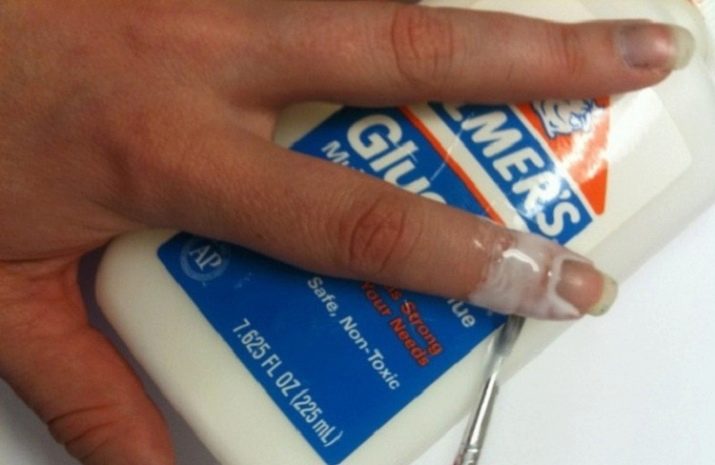
Design ideas
Regular varnish allows at home to not only gently paint nails, but also to make an unusual design on them.
An interesting option is to use a newspaper. First, the nails are covered with a base layer, then with white varnish. When it dries on the nails, pieces of newspaper with letters are moistened in alcohol for ten seconds and then firmly applied to the nail plates. Top coated with clear varnish.
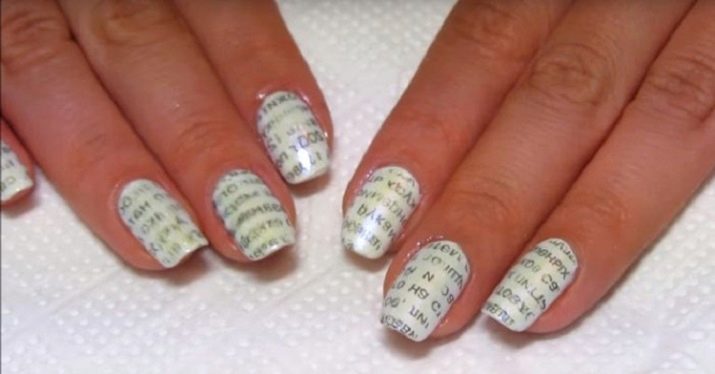
With a toothpick, you can easily perform a drawing on painted nails. To do this, take a varnish of contrast to the main color and apply points with a stick. You can distribute them on the surface in different ways. For example, at the very edge to make a lot of them, gradually reducing the number in the direction of the hole in the nail.
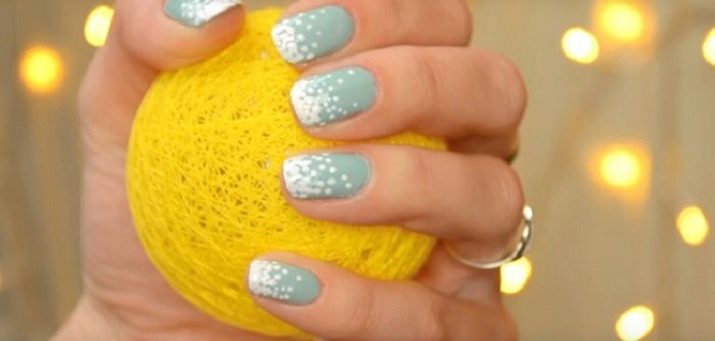
You can create a transition effect from one color to another. For this, several strips of varnish of different colors are applied in a row to an ordinary kitchen sponge. The skin around the fingers needs to be closed, for example, coated with PVA glue or wrapped with cling film (it remains to make a hole under the nail). Now you can make prints, then cover the nails with a transparent layer on top and remove the protective equipment from the fingers.
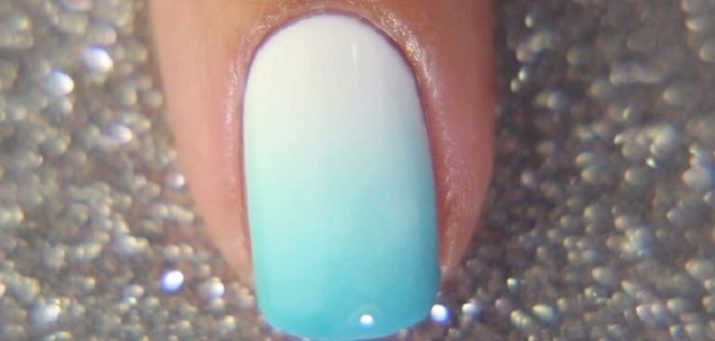
See nail polish design ideas for regular nail polish in the next video.










